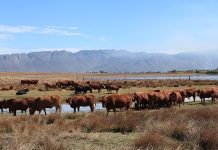International agricultural commodity prices increased significantly from 2004 to 2006. The maize price increased by 54%, wheat by 34%, soya oil by 71% and sugar by 75%. This trend accelerated in 2007. Wheat prices increased 35% over 2006, while the maize price increased 27%. T he increase in world food prices was caused by higher food demand and the use of food crops for biofuel production. International grain prices thus reached record levels in 2007, which also raised the prices of livestock products. The price of skimmed milk powder and butter doubled, while the price of cheese increased 81%. This was driven by increased food demand, especially in the developing world, where demand from the emerging middle class in China and India exploded. Higher oil and hard commodity prices resulted in an inflow of money into oil- and mineral-exporting countries, also increasing demand. In low-income countries the recent increase in the oil price aggravates the problem.
The increased financial burden of the higher energy bill makes it more difficult to afford food imports. Food security A ccording to a recent US Department of Agriculture (USDA) study, there are 849 million hungry people in the 70 lower-income countries around the world. Only 24% of the population of these 70 countries lives in Sub-Saharan Africa (SSA), but more than 40% of all food-deficient people live in SSA. Higher world prices make it expensive for developing countries to import food, compromising their food security. The Food and Agricultural Organisation estimated a 25% increase in developing countries’ food bills in 2007. The USDA prediction of the global food gap in 2016, based on two scenarios, is shown in Table 1. Scenario 1 assumes a price increase of 1% a year, while Scenario 2 is based on a price shock of 27%, the actual increase in world prices during the first seven months of 2007, and a 1% increase per year thereafter.
The food gap in all countries will increase as a result of higher international prices. Use of grain for biofuel has raised international grain prices. This trend will continue. Biofuel production will increase SA grain prices even though government took maize out of the biofuel mix. Currently, international stocks of most agricultural products are very low and availability may soon become a more pressing problem than affordability. Food security no longer means that one can get whatever one needs from global stockpiles.
Implications for agriculture in SA
The SA government still firmly believes in their land reform programme, which must transfer 30% of agricultural land to black owners, but SA won’t produce enough food for our population if that 30% is not run commercially. If this is run by subsistence farmers we’ll have to import massive quantities, which won’t be generally available on the world market and if available, may be unaffordable. Government must very quickly realise that the only hope for stability lies in a growing and prosperous agricultural sector. Although this is one of the objectives of the Sectoral Plan for agriculture, it gets very little attention from government and politicians. When the agricultural sector gave a presentation to the parliamentary committee on agriculture last year, nobody asked about their successful export drive, but they asked many questions about affirmative action in the industry.
Without a drastic change in government’s agricultural policy, we won’t produce enough food for our population. SA farmers can produce enough for our own use and for exports to the other SSA countries, but increasing production in SA will require cooperation between agriculture and government. You can only export quality goods if the inputs used are of good quality. The Department of Agriculture must get its house in order in terms of control over imported fertilisers and other chemicals. We can’t afford another pineapple disaster or another voluntary ban on exports to the EU. Higher world prices and lower stocks mean that individual farmers can look forward to a few years of relatively high product prices. Unfortunately, higher oil prices and a weaker rand will increase input prices. Thus, while farmers will enjoy better prices their bottom lines will still remain under pressure.
Dr Koos Coetzee is an agricultural economist at the MPO. All opinions expressed are his own and do not reflect MPO policy.








